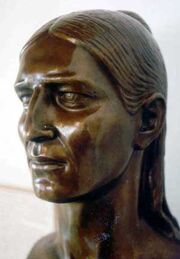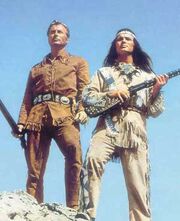Language: • Indonesia • English

Bust of Winnetou by Selmar Werner at Karl May's Museum in Radebeul, Dresden, Germany.
Photographed by: Seno Gumira Ajidarma/Pusat Dokumentasi Foto majalah Jakarta-Jakarta.
Winnetou was Old Shatterhand's best friend in Karl May's stories. He was the chief of the Apache Mescalero Indians. Winnetou's adventures can be read in series like Winnetou Series and Stories for Young People.
The Meeting
Winnetou met the character Charley or Old Shatterhand for the first time in a story titled Winnetou I (Winnetou I: The Apache Chief). At the time, Charley was still a surveyor working for the railway company. Winnetou with his father, Intschu tschuna who was still the chief, along with Klekih-petra, a white Christian missionary living with the Apache, visited the railway project site which passed through the land of the Apache to ask whether or not they had permission to build the railway there. In this event, occured a misunderstanding that led to the killing of Klekih-petra. But before he died, the missionary whispered to Charley and made him promised to accompany Winnetou in his place. This promise was kept by Charley.
The Misunderstanding
After Klekih-petra died, the Apache attacked the white men, whom was assisted by the Kiowa tribe led by Tangua. In the fight, Winnetou and Intschu tschuna was captured but freed by Charley without they knowing it. The fight continued and subsequently Charley and friends, Sam Hawkens, Dick Stone, Will Parker, along with Rattler, the culprit, was captured and taken to the Mescalero Apache's pueblo to be tortured at the torturing pole.
Friendship
Finally, Charley succeeded in proving that he, Sam, Will, and Dick were not guilty, even could establish a friendship with Winnetou, and liked by Winnetou's little sister, Nscho-tschi. Winnetou tought Charley, whom now was called Old Shatterhand, how to read tracks, even made him his blood brother. Since then, Winnetou and Old Shatterhand were inseparable.
Becoming Chief
Because of her fondness to Old Shatterhand, Nscho-tschi decided to live among the white men to learn their costom and tradition. But before her wish came true, this girl and Intschu tschuna, her father, was killed by Santer, Winnetou's arch-enemy. From then on, Winnetou became the Apache chief.
Origin of the Name

Lex Barker and Piere Brice as Old Shatterhand and Winnetou in a film titled Winnetou I.
Photograph taken from DVD box cover.
According to a theory by Adalbert Stütz, the author of Die Bedeitung des Wortes "Winnetou" (The Meaning of Winnetou's Name), Karl May did not use an Apache name, but derived it from the word vintu, the term commonly used by the gold miners. According to him, karl May fond this name in the collection of Albert S. Gatschet works in a book titled Zwölf Sprachen aus dem Südwesten Nordamerikas (Twelve Languages from South West of North America).
The truth is, Karl May himself only once gave a verbal explanation about the meaning of Winnetou, that is Brennades Wasser (The Fiery Water). In his autobiography, Karl May stated that the idea of the name Winnetou already in his mind when he was still in Osterstein prison. He said that he used this Winnetou name at once but called him Inn-nu-woh instead, a name taken from one Indian language. The story about Inn-nu-woh itself was published in the first edition of Deutsches Familienblatt (German Family Page) magazine in 1875.
The Silver Rifle
Winnetou always seen carrying the silver rifle which is his characteristic. With this rifle, he never missed a shot.
See Also
- Inn-nu-woh
- Old Shatterhand
- Nscho-tschi
- Silver Rifle
Sources
- Menjelajah Negeri Karl May by Pandu Ganesa, published by Pustaka Primatama, 2004 (ISBN 979973763-X).
- Gurun & Prairie I: Kumpulan Cerita, a collection of Karl May's short stories, published by Pustaka Primatama, October 2004 (ISBN 979973765-6).
- Winnetou: His Name and The Origin of It, by Werner Poppe, Appendix of Winnetou I: Kepala Suku Apache by Karl May, Indonesian language translation published by Pustaka Primatama, June 2003 (ISBN 979973760-5).